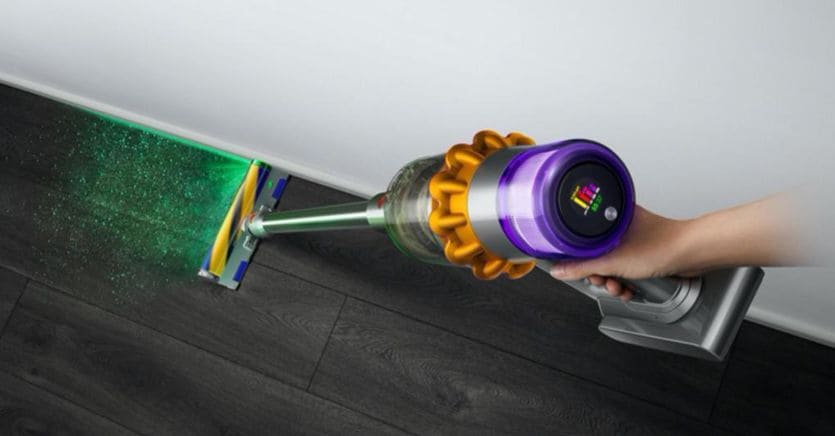Have you ever tried vacuuming in the dark? Probably not. And maybe you never will. But with the new Dyson V15 Detect in hand, the temptation is very high. If only to let yourself be carried away by that green laser positioned on the brush that irradiates the floor as if it were an infrared camera.
We tried this model for a few days, now on the market in Italy. There was a lot of curiosity, because upon arrival on the American market, the Dyson V15 Detect had won the critics. And our expectations were not met. Aspiration is the trademark: fluid, powerful and precise, thanks to the Dyson Hyperdymium engine that generates up to 240 air watts of suction. But it is the whole mix of technology that has impressed us.
There are at least three aspects to underline: the laser detection of dust, the acoustic detection and the new anti-tangle brush. Let’s see what it’s about.
The laser on the brush
Dyson has designed laser technology for dust detection. The system – which we approached with some diffidence – reveals particles that are not normally visible to the naked eye with a precisely angled laser integrated into the brush. And it’s really kind to see piles of dust that we hadn’t seen with the naked eye.The idea came when a Dyson engineer noticed that airborne particles in the house glowed in the sun. The research phase has therefore started to understand how to apply this phenomenon to the fine dust invisible to the naked eye present in our homes. The team conducted experiments in the laboratory with lasers to see how they could achieve this and that’s how this new solution was born.Dyson engineers integrated a green diode laser – chosen for its ability to create the best contrast. – in the Slim Fluffy brush, positioning it precisely at an angle of 1.5 degrees to 7.3mm from the ground. Really a nice innovation.
Loading…
The piezoelectric sensor
With the V15, Dyson engineers are committed to developing a technology that allows the user to measure the detected dust and view the results on the LCD display for real-time scientific proof of thorough cleaning. How does it work? A piezoelectric sensor has been integrated into the vacuum cleaner. The carbon fiber filaments in the brush collect microscopic particles which are measured and counted up to 15,000 times per second. The dust enters the vacuum cleaner and hits the piezoelectric sensor at the inlet of the container and the slight vibrations are converted into electrical signals. The size and amount of dust is shown on the integrated LCD display, so that the user can know how much dust the vacuum cleaner has removed and the different particle sizes to vacuum. The small display, in fact, becomes like an exhaustive picture of what we are aspiring to, with the numbers growing in real time. But there’s more: the vacuum cleaner is designed to automatically increase the suction power when it encounters more dust. This happens in automatic mode, when the piezoelectric sensor detects high concentrations of dust, the reactive suction power is activated to automatically increase the power. When the dust level normalizes, the suction power returns to its previous level.
No more tangled hair
Finally, the new anti-tangle brushes. The Dyson folks also worked to solve the problem of removing hair from the vacuum cleaner brush. It is a common challenge for many vacuum cleaners, so the British house has developed a new conical anti-tangle roller that through a spiral movement collects the hair inside the container, to prevent them from tangling around the roller. Designed for hair and pet hair, our engineers have meticulously developed the precise angle of the device’s bristles to ensure the release force doesn’t tangle your hair. The brush has been tested on different types of hair. “As engineers we are tasked with solving everyday problems and the last 12 months have created a lot of new problems, because we spend more time indoors,” said James Dyson, Chief Engineer and Founder of the homonymous company. “We all clean more frequently, trying to remove too much dust, with the desire to live peacefully in a really clean house. We think that dust detection alone is not enough, so we meticulously remove, measure and classify particles 15,000 times per second via a piezoelectric sensor that converts vibrations into electrical signals, accurately showing on the LCD, located at the back of the vacuum cleaner. , the size and number of particles sucked in. ”The Dyson V15 Detect vacuum cleaner is on the market from today at a price of 699 euros.
